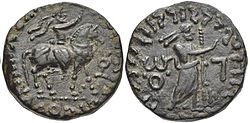Top Qs
Timeline
Chat
Perspective
Sases
Apracha King From Wikipedia, the free encyclopedia
Remove ads
Sases, also known as Gondophares IV Sases (Kharosthi: 𐨒𐨂𐨡𐨂𐨥𐨪 𐨯𐨯 Gu-du-pha-ra Sa-sa, Guduphara Sasa[1][2]), sometimes Sasan, was an Indo-Parthian king and Apracharaja[3] who ruled in Gandhara. He is only known from coins and ruled for at least 26 years after succeeding Gondophares.[4] At some point during his reign he assumed the title Gondophares, which was held by the supreme Indo-Parthian rulers.
With the modern datings supplied by Robert Senior, Gondophares IV is a likely candidate for several possible historical references to Indo-Parthian kings of the 1st century AD. Traditionally, these references have been thought to be about Gondophares I, as earlier scholars did not realise that "Gondophares" became a title after the death of this king, just as the name of the first emperor, Augustus, in the Roman Empire, was used by all later emperors as a title.[5]
Remove ads
Rule

During the dominion of the Indo-Parthians, Apracharaja Sasan, as described on numismatic evidence identifying him as the nephew of Aspavarma,[7] emerged as a figure of significance.[8] Aspavarman, a preceding Apracharaja contemporaneous with Gondophares, was succeeded by Sasan, after having ascended from a subordinate governance role to a recognized position as one of Gondophares's successors.[9] He assumed the position following Abdagases I.[10]
The Kushan ruler Vima Takto is known through numismatic evidence to have overstruck the coins of Sasan, whilst a numismatic hoard had found coins of Sasan together with smaller coins of Kujula Kadphises[11][12] It has also been discovered that Sasan overstruck the coins of Nahapana of the Western Satraps, this line of coinage dating between 40 and 78 AD.[13]
Remove ads
Connection with Phraotes
Summarize
Perspective

In the 1st century CE, Phraotes, a Greek-speaking king of the city of Taxila, was met by the philosopher Apollonius of Tyana dated approximately to 46 CE, according to the Life of Apollonius Tyana written by Philostratus. The Gondophares who fits this date is Gondophares IV Sases, whose coinage has been dated to 40-78 AD.[14] Apollionus describes the king as an Indian.[15]
They describe Phraotes' residence, Taxila, as being the same size as Nineveh, being walled like a Greek city whilst also being shaped with Narrow roads,[16][17] and further describe Phraotes kingdom as containing the old territory of Porus.[18] Following an exchange with the king, Phraotes is reported to have subsidized both barbarians and neighboring states, with the objective of averting incursions into his kingdom.[19] Phraotes also recounts that his father, being the son of a king, had become an orphan from a young age. In accordance with Indian customs, two of his relatives assumed responsibility for his upbringing until they were killed by rebellious nobles during a ritualistic ceremony along the Indus River.[20] This event led to the usurpation of the throne, compelling Phraotes' father to seek refuge with the king situated beyond the Hydaspes River, in modern-day Punjab, a ruler esteemed greater than Phraotes' father. Moreover, Phraotes states that his father, received an education facilitated by the Brahmins upon request to the king and married the daughter of the Hydaspian king, whilst having one son that was Phraotes himself.[21] Phraotes proceeds to narrate the opportune moment he seized to reclaim his ancestral kingdom, sparked by a rebellion of the citizens of Taxila against the usurpers. With fervent support from the populace, Phraotes led a triumphant entry into the residence of the usurpers, whilst the citizens brandished torches, swords, and bows in a display of unified resistance.[22]
Remove ads
Family tree
See also
Notes
References
Wikiwand - on
Seamless Wikipedia browsing. On steroids.
Remove ads

